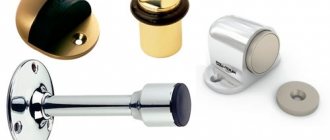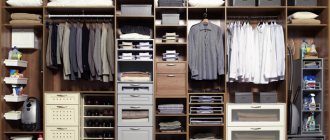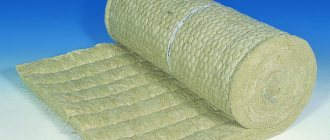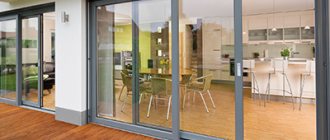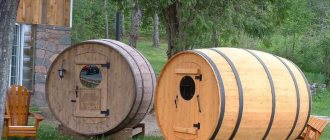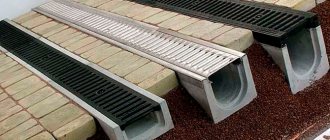Sliding doors for arranging interior openings have gained great popularity due to their attractive appearance and practicality of use. They are a type of sliding systems in which the door leaves open, moving parallel to each other or the wall. For such movement, special roller guides are used. The most popular option for such door designs is a system with an upper guide roller and a lower one, which serves as a support.
However, there are other design solutions that allow you to achieve the required aesthetic or practical effect. Today, manufacturers of doorways and guide roller systems are trying to diversify their product range as much as possible, so that owners of apartments and houses can implement all kinds of design ideas for arranging interior doorways.
Types of interior sliding doors
Do you want interior doors to be stylish, functional and not take up much space? All requests are met by compartment doors that move along two guides. Slider doors are:
- single-leaf - compact, one leaf moves sideways;
- double-leaf and multi-leaf - an option for large rooms, two leaves move in different directions.
Classification according to opening principle:
- Accordion doors. They fold according to the principle of blinds. They differ from book doors only in the number of panels. Suitable for a narrow corridor, dressing room, bedroom, office. They are distinguished by affordable prices.
- Pencil door. Modern design with a high degree of sound insulation. The peculiarity is that when opened, the canvas goes into the wall.
- Coupe doors. The most common option. The doors silently move along the wall, significantly saving space.
Accordion doors
Based on manufacturing material:
- solid wood;
- glass;
- aluminum;
- plastic;
- MDF, chipboard and their combinations.
By type of design:
- rail - the load is distributed along the lower guide;
- suspended - the main load is on the upper guide.
How does a cassette sliding system work?
According to the principle of operation, cassette interior doors are no different from designs that require the door to be rolled back behind the wall. The mechanism consists of rollers and guide rails. The main difference is the ability to hide the door leaf inside the wall. This design is called a cassette or pencil case. It is made in the form of a flat box, replacing part of the wall. In addition to the sash, guide rails and a roller system are hidden inside the cassette.
The benefit of a pencil case for sliding doors is the creation of free space inside the wall; the door that rolls back into the cassette does not interfere with installing furniture close to the interior partition. The pencil case protects the door leaf from dirt, scratching by pets and other damage.
For normal operation of a sliding door, a wall thickness corresponding to the parameters of the cassette is required. The structure should form a niche that does not protrude beyond the plane of the pier. In the sliding system, the thickness of the sash and the side posts of the pencil case, as well as the gaps between the elements for the free movement of the canvas, are taken into account. The width of the cassette is always made twice as large as the doorway. The half, intended for rolling back the canvas, is hidden behind a false plasterboard wall.
Advantages and disadvantages of sliding doors
Sliding doors are less common than swing doors. This means this is a great opportunity to bring a touch of originality to your apartment. A sash moved to the side can look like an exclusive wall panel and decorate the interior.
Advantages:
- non-standard solution;
- space saving;
- the absence of blind areas, which makes it easier to arrange furniture;
- low noise level when opening;
- safety: children will not bump into the open corner of the door;
- easy to open and close;
- a draft will not slam the compartment door;
- you can divide the room into zones;
- a convenient solution for people using a wheelchair.
MDF sliding doors
Flaws:
- prices are an order of magnitude higher than the cost of swing doors. An unusual installation method increases the cost of hiring a professional. However, if you figure it out, you can make sliding doors yourself;
- low noise and light insulation if the sash is not completely closed;
- Door locks require non-standard ones, which means they will cost more;
- the rollers may break, so you should immediately buy spare ones.
When installing a sliding structure is justified
And, nevertheless, sliding doors have not yet disappeared from stores, which means that their shortcomings can be taken into account under certain conditions. Such situations, when installing a sliding door is really advisable, arise due to planning errors, when all four door opening zones are occupied by furniture, household appliances or plumbing fixtures. As a rule, this occurs when placing a door in the middle of a wall, but if the doorway is moved into a corner, at least on one side there will always be a place for an open door leaf, because there is inevitably a passage area where installing furniture makes no sense.
Another opportunity to choose a sliding door type is when complete isolation of one room from another is not required. This applies to dressing rooms or bathrooms adjacent to the bedroom. In this case, the purpose of the door becomes purely formal; it only prevents direct visual contact, while the difference in the heights of the door blocks, as a rule, is resolved by abandoning the upper casing or slope in favor of a false frame.
The possibility of installing a sliding door is always associated with the possibility of constructing a niche in which this door is hidden. Otherwise, there is no gain in terms of saving space: neither furniture nor any household utensils can be correctly installed in front of the open canvas, and the level of sound insulation will be zero. At the same time, when closed, the upper casing protrudes away from the door, which looks ridiculous. And even this installation option may be unacceptable: dust accumulates in the cavity of the false wall, which is unacceptable if any of the residents suffer from allergies.
You need to know that in certain cases a sliding door can be a replacement for a swing door, even if not a complete one. The configuration of the room and the layout dictate their conditions; sometimes in order to open the sash normally, you have to reduce the width of the opening to 60–50 cm, which is extremely inconvenient. If the door is not formal, it is allowed to use sliding fittings, but of a special type. We are talking about imported products, including a low-speed movement mechanism, devices for pressing a closed leaf, as well as special multi-row brushes, which are only slightly inferior in sound insulation to a swing door. There is only one downside to such hardware kits - the exorbitant cost, so it is always better to think repeatedly about the possibility of moving the opening closer to the corner or changing the layout.
Sliding door mechanism
The main difference between sliding and swing structures is in the mechanism. Therefore, when choosing, you need to pay special attention to:
- Hidden mechanism (internal). The structure can only be installed during the construction phase in order to leave a free niche in the wall for the door. Installation is complex, so it is best handled by qualified craftsmen. The area of the room will decrease slightly, but there will be a free partition where you can move furniture or hang a panel.
- Open mechanism (external). Very popular because it can be installed at any stage. Reconstruction of interior partitions is not required. Even a non-professional can handle the installation. The door leaf moves along the guide to the left, right or in both directions.
Sliding doors with open mechanism
Doors with three or four leaves can be installed on large niches, where the middle leaf (or leaves) slides in one direction or another.
How to choose
Classic, or hinged, sliding doors are selected based on several key criteria. Here you need to consider:
- the size of the canvases, determined by the dimensions of the doorway;
- appearance (for example, the doors to the hall must match the furniture, finishing of the floor, walls and ceiling, and other interior characteristics of this room);
- the possibility of installing one or another type of roller guide profile, which can be made in a doorway that has its own specifics (variants of sliding doors are often chosen taking into account the architectural characteristics of the opening);
- installation location (for example, if doors are chosen for the hallway, compartments in the corridor should take into account the specifics of this space, open in a convenient direction, sliding out, not touch furniture, not cover switches, etc.)
When choosing sliding door systems, the cost of such interior products is important. On the one hand, owners do not want to overpay for famous brands, and on the other hand, in no case should they sacrifice quality. The latter is extremely important, because this functional interior device will be used intensively on a daily basis.
All parts of the mechanism, from the canvas to the rail on which the roller will slide, must be strong and wear-resistant. They must correspond to each other in terms of design and functional parameters. Thus, the strength of the profile guide must correspond to the weight of the door leaf. If the latter is made of plexiglass, then special rollers with a clamping mechanism are used.
Selection of compartment doors
Before you go to the store, you need to decide on the mechanism of the sliding system. When purchasing, pay attention to:
- country of production: Italian designs are considered the highest quality;
- door material - depending on the style and type of room.
Sliding doors can be installed in classic living rooms and modern kitchens. The best option for classics is solid wood or veneer, while glass and aluminum are more often used for minimalism or high-tech style. Baroque involves the presence of arches, stained glass and carvings. This means that wood with glass inserts will do.
Attention! If we are talking about glass, it is better to choose tempered glass or triplex. These options are the most resistant to damage.
Options for different rooms:
- Living room. Valuable species are ideal: larch, ash.
- Kitchen. The best option is glass. The doors not only look interesting, but are also moisture resistant.
- Children's room. Choose natural materials with good sound insulation to ensure a restful baby's sleep.
Sliding doors appeared in Asian countries; in Japan they are made of paper. Therefore, if the room is decorated in an oriental style, a lightweight sliding structure upholstered in thick paper with bright patterns will be ideal.
Choose reliable fittings to make the door last longer
Components of the kits
In terms of their design, the various mechanisms of sliding doors differ little from each other, except perhaps in the specifics of the displacement of the leaves. Therefore, the kits include almost the same elements; the only difference is in their number and design.
Rails
Profiles are mainly used as guides in sliding door systems.
The difference between them is the number of “tracks”. The specifics of the application depend on how exactly the canvas covers the opening: end-to-end or overlapping. In fact, these are traditional sliding doors, well known to many. When choosing a profile, the metal from which it is made also matters. For massive doors, it is better not to use aluminum (even though it is cheaper); Deformation will cause problems with sliding doors - only steel.
Roller bearings
They also differ in design features. The required number of wheels (and the upper mechanisms can have up to them is determined by the weight of the leaf and the type of sliding system. There are also differences in the arrangement of the wheels themselves: symmetrical or offset (asymmetrical). For doors weighing no more than 80 kg, roller mechanisms with two supports can be used But for massive canvases, at least four are installed, which is associated with an increased load on the structure.
The required number of wheels (and the upper mechanisms can have up to them is determined by the weight of the leaf and the type of sliding system. There are also differences in the arrangement of the wheels themselves: symmetrical or offset (asymmetrical). For doors weighing no more than 80 kg, roller mechanisms with two supports can be used But for massive canvases, at least four are installed, which is associated with an increased load on the structure.
Locking elements
They are not basic, but perform important functions. The first is to prevent a “hard” impact of the door on the wall (if the opening is located close to it) or the roller flying out of the guide. Such parts are called motion limiters. The second is fixing the door in a certain position. This is necessary in order to prevent spontaneous movement of the canvas. This is possible, for example, in the event of a strong draft or disruption of the horizontal orientation of the rails due to shrinkage of the structure.
The sliding door mechanism can be additionally equipped with automation elements (closers, mini-electric motors, cables, hooks, etc.). But they do not make any changes to the principle of its functioning; They only increase ease of use, nothing more.
Features of fittings
High-quality fittings are the key to a long service life. Fittings for sliding doors include:
- profile;
- guides, stopper. The modern design is a load-bearing suspension that can withstand heavy loads. It is convenient because there is no guide at the bottom that you can trip over;
- rollers. Vary depending on the installation mechanism;
- handles can be mortise or semi-hidden;
- fastenings
Experts advise buying components made in Germany or Italy.
Advantages of sliding construction over other types
The advantages of sliding doors are the elimination of the disadvantages of swing doors. The use of sliding panels makes it possible to save useful space in the premises. In addition, sliding doors do not block passage and access to other openings.
Sliding structures are not capable of opening involuntarily. At the same time, the roller mechanism makes it easy to move the sash along the slide with minimal effort.
When moving the door leaf eliminates any possibility of injury: it is impossible to slap someone on the forehead with it
Sliding structures - those that move using rollers along a guide rail - are durable. Their service life is calculated in decades.
During operation, such structures do not creak, do not warp, and do not rub circles on the parquet.
Is it possible to make compartment doors with your own hands? Feedback from practitioners
Domestic masters answer this question unequivocally. Many people install purchased doors themselves or buy the door leaf and components separately, and then assemble the entire structure with their own hands. In reviews there are even cases of successful conversion of swing doors to sliding ones.
In general, reviews of sliding structures are positive. Owners recommend plexiglass or plastic to make the interior light and airy. Many people prefer top rails to avoid visually cutting up the space with a stripe on the floor and not tripping over the “rail.”
Sliding door installation diagram
Standard and non-standard door leaf sizes
Standard
As for the size of canvases, each state has its own standards. In Russia, the height is usually two meters (the rough opening height is 210 cm), and the width of single-leaf products is from 0.6 to 0.9 m .
Manufacturers produce sliding structures in the same size range. Therefore, choosing the right product option for a standard opening will not be difficult.
Non-standard
Considering that non-standard options are made to individual orders, they will not be cheap. When manufacturing products, materials such as glass and mirror are often chosen.
Glass devices give the interior lightness and weightlessness, while mirror ones make the room visually larger. Equally popular are blind products made from various wood species.
An option for a non-standard sliding design is a glass door
If you want to order products whose width is larger or smaller than generally accepted standards, make sure that you have enough space for the doors to open completely. To do this, measure the width of the vertical surface. It should be larger or equal to the width of the canvas.
Non-standard height products can also be made to order. These are, for example, models with arches or transoms.
DIY installation. Preparation
If you look at it, installing a sliding door is quite simple, but it will require more components than installing swing doors.
Advice. It is better to carry out installation immediately after finishing. If you are removing an old door, then you need to tidy up the mounting points of the frame. The floor should also be level, without distortions.
If you have decided on the dimensions, then you need to stock up on the following materials and tools:
- lower and upper guide;
- door leaf;
- lower and upper frame;
- upper and lower rollers;
- seal;
- pen;
- screws, nails, anchors;
- door, mallet, screwdriver.
Features of repair depending on the design
In accordance with customer requirements, 2 types of structures are installed: with and without a pencil case. Each type of repair has its own characteristics.
Door with pencil case
The design with a pencil case is similar to a video cassette. During installation, the inner part of the wall is removed and framed in a rigid box. A sliding system is installed inside. The canvas slides into the freed space like a cassette that is hidden in a box. The resulting recesses are covered with sheets of plasterboard, and then with finishing building materials - plaster, paint or wallpaper.
When repairing an automatic sliding door, the owner can remove the door leaf. This advantage avoids damage to parts. The rails are adjusted using a level. The guides are placed strictly in a horizontal position, otherwise the structure will warp and stop closing.
When replacing parts, you need to take into account the dimensions of the pencil case. The block must exceed the dimensions of the sash if it goes completely into the frame. The door is mounted at a height of 5-6 mm from the floor - this will ensure maximum sound insulation.
External sliding door
The external sliding type includes systems in shower stalls. Natural wear and tear of elements is accelerated by aggressive detergents and hard water. Under their influence, lubricant is washed out, small holes become clogged, plastic cracks, and corrosion appears on metal parts. When replacing rollers, the cabin pays attention to their type. Fixed mechanisms are used in square and rectangular booths, rotating ones - in round ones.
Sliding opening systems are also installed in wardrobes. Repairs are carried out using the adjusting feet under the bottom bar of the housing.
Step-by-step installation guide
You should start by installing the guides. Then mark the installation location and start fastening from the bottom:
- Install the guide so that it is 2 p. larger than the opening and on one side extended beyond the opening line by 50 mm.
- The upper guide is first attached to the beam, then installed above the opening.
- You need to install stoppers along the edges of the top rail to prevent the door from opening on its own.
- Install the handle on the sash using a mallet.
- The last stage is the installation of the door leaf and seal.
Sliding door with glass insert
My version of manufacturing sliding systems
The process of making and installing doors with a sliding mechanism yourself is quite simple and even a beginner can do it. The main thing is to know how to properly handle construction tools and have general skills in carrying out installation work.
To install a stylish, practical and reliable entrance group with a sliding structure, we will need:
- screwdriver and drill. If you plan to install doors in a concrete opening, then take a hammer drill;
- set of bits for self-tapping screws;
- measuring instruments: plumb line, level and tape measure;
- nails and screws;
- pencil;
- saw for wood and metal. You can use either hand saws or take a grinder with a circular saw.
To make the canvases and the sliding mechanism itself, I used:
- OSB sheets (the same ones I used for cladding the house);
- wooden blocks (I used them as a platform for mounting door fasteners);
- sealed bearings in a metal cage (4 pieces);
- bushings installed in the inner part of the bearing;
- bolts with washers and nuts;
- metal plates (4 pieces);
- I used a channel as the top guide;
- The role of the lower guide is played by a wooden block.
I also used a narrow strip - I attached it to the edge of the door leaf in such a way that when the doors are closed, it completely covered the gap between the leaves. Which also had a positive effect on protection from drafts.
The installation procedure is simple and consists of the following steps:
- Marking and cutting OSB sheets. To make the cut look as neat as possible, it is better to use a circular saw.
- Attaching a wooden block to the top of the door leaves.
- Preparation of metal plates. They must be strictly the same size. On one side of the plates a hole is drilled for a bolt, on the other there are many small holes for attaching screws.
Assembling the roller mechanism. To do this, you need to attach the plates to the wooden trim on the doors (2 plates per panel). Then use bolts to secure the bearings to the plate.
Installing the top guide. There's nothing complicated about it. The main thing is to remember to use a building level. Hanging doors and installing bottom guide. This is the final stage of installation.
As you can see, installing sliding doors yourself is a simple procedure. All work can easily be done with your own hands within one day.
Glass door decoration
If you want to add new notes to the interior, and your door has parts with glass, then you can draw patterns on them. Stained glass looks relevant in a classic interior and rococo style. To work you will need:
- PVA glue;
- stained glass paints;
- aluminum wire.
After you have selected a suitable ornament, you need to remove the glass. Then:
- Glue moistened paper with a pattern on it to the glass.
- Glue the wire along the contour of the picture.
- Apply paint.
There is another way to apply stained glass, without wire. In this case, the template is cut out of thick cardboard and attached to the removed glass using tape. In addition, you can apply a pattern to the glass using the dot technique or decoupage technique. This design will make your door truly unique.
A sliding sliding door will be an excellent option for any home or apartment. It will decorate a small or spacious room; if installed correctly, it will be easy to use.
Types of installation of the mechanism: along and inside the wall
There are two ways to install interior doors on rollers.
When installing “along the wall,” a beam with a guide for moving the rollers is attached to the wall panel. After completing work with the mechanism, the doorway is decorated with platbands.
When installed “inside the wall,” the fasteners go deep into the panel (or its plasterboard imitation). Fastening inside the wall requires redevelopment (if not carried out during construction). The door leaf will have to go inside some kind of “garage” (pencil case or cassette), and for this you need a false wall
It is important to consider the position of the handle; it is clear that it cannot be the same as on a traditional door. A door with a drive inside the wall provides greater tightness than with the above method
Along the wall
A beam is attached to the wall. Next, a sliding mechanism guide is installed on it (rollers move along it). The rollers are attached to the end of the door (top) using a special bracket. To keep the door from oscillating, a groove is cut at the bottom end for a guide flag, which, in fact, holds the door. Then the doorway and guide are finished with platbands and extensions.
Excellent space saving by opening the door along the wall
With this installation option we get low sound and thermal insulation, as well as poor tightness.
Inside the wall
Here the fastening is hidden inside either a false wall or a plasterboard wall. This installation requires redevelopment, that is, you need to make a U-shaped groove in the wall. It is much easier to install the required groove if you are building a new wall. A hidden door can also be installed in a finished metal structure, such as a pencil case or cassette. They are first installed in the wall, then plastered or plasterboard is applied. And don’t forget that such a door is hidden in the wall, so you need to think about the correct placement of the handle.
We advise you to study - Types of spray guns, their differences, pros and consOpening the wall inward not only saves space, but also promotes greater airtightness
This option provides excellent sound and heat insulation, since the door leaf is tightly connected to the opening, hence the tightness.
Sliding doors in the interior: photo
Non-standard dimensions
For foreign-made doors, the domestic standard for the height and width of the doorway does not match. More often, blocks are 2 m high, plus or minus from 10 to 15 cm. Width is from 60 to 90 cm.
French standards differ from domestic ones by reducing the size of the door by 1 cm. If we compare two doors with a width of 90 cm, then the parameter for the imported door leaf is 89 cm.
A non-standard opening size is often typical for private houses built according to an independently developed project. Modern designers love to use doorways up to the ceiling. They increase the space and make it possible to create a unique room design. Such options are less common inside new buildings with a modern layout.
For non-standard dimensions of the interior door opening, you have to order a door block individually. There are companies that provide a similar service, but the cost of the product will be overestimated by 30 percent.
Interior doors have non-standard width and height. Dimensions depend on the installation location of the unit. Typically, high and wide doorways are installed for the living room or kitchen. For a bedroom or bathroom, the entrance is made smaller - from 55 to 60 cm.
Types of roller mechanism and door leaf
The type of sliding doors determines the mounting option for the roller mechanism. The quality of its parts will show how easy the structure will be to use and how long it will last.
Types of opening mechanism:
With the hanging method, only one guide is used, which is mounted at the top of the wall. It must be very reliable (strong and high quality), since the entire weight of the door leaf will fall on its structure. Since there is no bottom threshold, the model has very low heat and sound insulation.
When installing the coupe version, the main guide is the bottom bar. It bears the entire weight of the door. The top bar helps movement. Directs along the desired path and supports the canvas. In this case, more powerful rollers are attached to its lower part. The upper part uses light wheels, which are necessary to orient the structure in space.
A sliding door is suitable for those who are looking for a cost-saving option while maintaining good functionality. The footsill adds some warmth and noise insulation, but is also an obstacle to free movement.
The best option is to install a sliding model. It looks great in any room, since all the mechanisms are hidden inside the wall. Usually an artificial niche is created from plasterboard, which hides all the details.
Both variations can be used here. That is, install a door with one guide or use two strips at once. Regardless of the alternative, installing such a structure is difficult because it requires demolishing part of the wall to create a niche. Of course, choosing this option will require significant financial investments in renovating the premises.
The canvas is practically no different from the swing model. If wood is preferred, pine is usually taken as the basis and decorated in various ways (painted, veneered, varnished). As a rule, they try not to weigh anything down. But if there is a desire to use more noble types of wood (oak, ash, beech), then you will have to select a very reliable opening mechanism. Because the canvas will be heavier.
Glass and mirror canvases are popular. For their manufacture, they take hardened material and, as a rule, mostly matte. The structure can be solid or combined with wood, plastic or metal.
Types of doors made of plastic are no less common. They are distinguished by increased lightness and ease of installation. Plus, they allow you to save a little money. The opening mechanism will cost much less than, say, an oak door.
Metal sheets are used less frequently. Only aluminum is chosen for the door, otherwise the structure will be too heavy and not a single closing mechanism will support it. Metal is used in the design of any particular style. For example, loft, modern or high-tech.
Requirements for a construction opening
To install a sliding interior door, it is necessary to take into account the peculiarity of its operation strictly in one plane. It is important to ensure the same distance from the wall for its smooth movement.
If the doorway is uneven or deviates from the vertical, then before installing the sliding structure you will need to level the wall or mount it at a considerable distance.
Pros and cons of swing
The traditional option in apartments in the post-Soviet space is doors with one or two leaves that swing open in one direction. This solution is familiar and convenient; it is preferred by most manufacturers and developers. What is the reason for such a craving for tradition?
Swing doors have a number of advantages:
- price - the price range for door leaves and fittings is also wide - that is why the finishing from the developer includes exactly this version of doors;
- suitable for any position of the doorway - for example, located in a small area at an angle to the side walls or at the end of the room;
- classic appearance, suitable for any design;
- the possibility of making to order or purchasing a ready-made model that fits the size;
- safety and the possibility of an upgrade - improving fittings, door panels, replacing parts of the door frame as they become unusable, etc.
How to choose a partition
There are a great variety of interior partitions, which is why it is so difficult to choose the appropriate option. Today we will talk about how not to get lost in this diversity.
The main disadvantage is the space requirement: the doors must have room to swing open. That is, the distance in front of the door and along the wall where the hinges join must correspond to the size of the door; nothing can be placed there. This is inconvenient for small apartments, where every square meter of space is saved.
Arched doorways
The dimensions of arched interior openings depend on the architectural features of the building. The width of the arch can be selected individually, and the height is limited by the ceiling. If the distance from the floor to the floor slabs is 2.5 m, then the arch is made with a maximum height of 2.2 m. For high ceilings of 3.2 m, an arched structure with a height of 2.6 m is suitable.
Many manufacturers do not indicate the dimensions of finished arches. The technical documentation often specifies the permissible interval. An example is an arch with a maximum height of up to 2.4 m, a thickness of up to 18.5 cm, and the width range varies from 79 to 150 cm.
